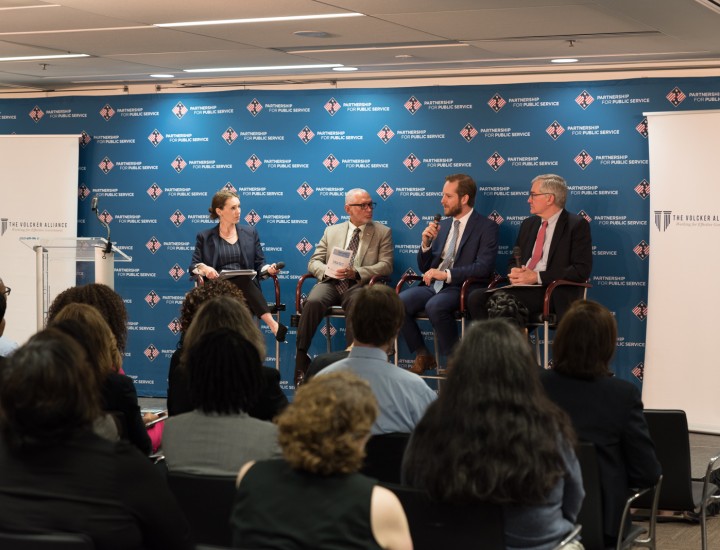Volcker Alliance Sponsors Paper on the Future of Public Service

1:00AM
On September 25, 2018, a Panel of the National Academy of Public Administration today released a new white paper on the future of public service, sponsored by the Volcker Alliance and the Samuel L. Freeman Charitable Trust. The paper, called No Time to Wait Part 2: Building a Public Service for the 21st Century, is a follow-up to the original No Time to Wait white paper released by the Academy in 2017.
No Time to Wait Part 2 recommends changing the civil service system's culture of compliance to a promise of performance. "This new report makes a compelling case for action," said Panel Chairman Donald F. Kettl, a Nonresident Senior Fellow at the Volcker Alliance, Academy Fellow, and Professor at the Lyndon B. Johnson School of Public Affairs at the University of Texas at Austin. "The federal workforce is the bedrock of the government’s ability to function, so there is even less time to wait than ever before. The Panel recommends specific steps that will help to bring the federal workforce into sync with the modern-day challenges we face, and we urge our leaders to take these recommendations seriously."
The paper was released this morning at the National Press Club in Washington, DC. The Panel’s recommendations were discussed by a blue-ribbon panel of experts in the field of public administration, including Panel Chairman Donald Kettl; Academy President and CEO Teresa Gerton; Academy Fellow Anita Blair; and Angela Bailey, the Chief Human Capital Officer at the U.S. Department of Homeland Security. In addition, Bryan Hancock, a Partner with McKinsey and Company, delivered remarks on the Future of Work. The event was sponsored by Management Concepts, Inc., and Managing Director Debbie Eshelman moderated the panel discussion.
No Time to Wait Part 2 makes five principal recommendations to:
• Build flexibility into the pursuit of the mission - Federal leaders know best what they need to do their jobs, and they should have the flexibility to build the systems to meet those needs. Evidence should drive the system to what works best, through a four-part strategy: experiment, test, learn, then authorize.
• Replace current detailed job specifications with a competency-based talent-management model - Competencies should be vested in individuals and individuals should be matched to missions, instead of having static occupations define both. Rules have encrusted the federal personnel system to the point that compliance has become the driving rule. The federal government needs a system that recognizes that it doesn’t matter where government employees sit—what matters is what they know and how they contribute to the mission.
• Reinforce the pursuit of merit-system principles - These principles have become even more encrusted in rules than job classification. Nonetheless, the core values of the system remain: hiring and promoting federal employees based on what they know, not who they know; and ensuring that they can do their jobs without political interference. The system must be recast to advance these principles while freeing them from the rules that too often bind them.
• Lead from the center - The federal government needs a strong enterprise-level entity to lead the transformation of its human capital system. It needs to focus on encouraging flexibility and innovation in federal agencies, on promoting government-wide merit-system principles, and on developing a learning system so that government can move forward at the speed of innovation.
• Transform the federal government’s human capital backbone - Title 5 of the U.S. Code is the system’s core, but it hasn’t had a thorough housecleaning in decades. Some of these changes require legislation, but more than half of the necessary changes can be accomplished through administrative action. A task force of federal chief human capital officers should be given 90 days to draft a plan of reforms that can be implemented administratively.
The Volcker Alliance is involved in supporting several efforts to modernize the civil service system, including Renewing America's Civil Service in collaboration with the Partnership for Public Service, which has issued a set of recommendations that complement those described in No Time to Wait Part 2.


